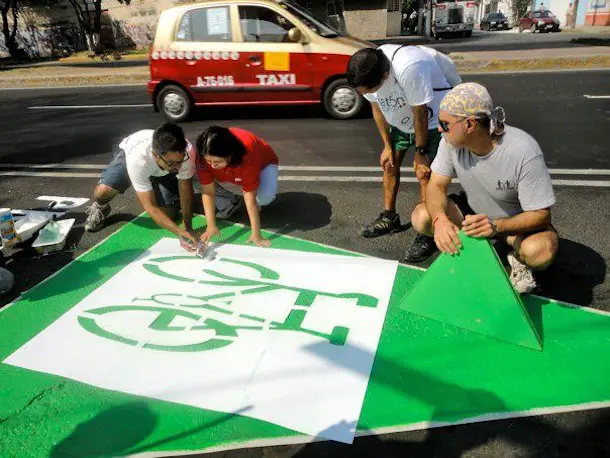Last week, a news story started doing the rounds about how the internet weighs the same as a strawberry. And whilst this makes an awesome headline, it is totally not true. Behind the seemingly immaterial internet lies an incredible physical infrastructure, part of which New York based filmmaker Ben Mendelsohn features in his new documentary ‘Bundled, Buried, and Behind Closed Doors’.
Ben’s short film focusses on Lower Manhattan’s 60 Hudson Street – one of the world’s most concentrated hubs of Internet connectivity. Within this ordinary looking building, huge amounts of data are exchanged, essentially keeping us all online. Last week, I was lucky enough to get the opportunity to ask Ben about his work, the future of the internet, and life before the fusion of urban and online interactions.
Joe Peach: One of your interviewees mentioned the importance of remembering the physical nature of the internet, and you expressed a feeling that ‘something important’ is happening at 60 Hudson Street. How could we do a better job of celebrating the incredible physical system that the internet has grown into? Or should it remain behind the scenes?
Ben Mendelsohn: This is really the core of the project for me. There is a writer in New York, Andrew Blum, who has a book coming out about physical Internet infrastructure. He was giving a lecture and handing out postcards of “data monuments” in New York City, and I asked him if these are monuments, what is their message or symbolism? What do they reveal about the culture that built them? The answer is that their message is one of ambivalence: while their presence is not completely concealed, it’s not flaunted either. Although service providers need to let potential clients know where they are, they generally decline to make their presence known beyond that market. Andrew did say that he envisions “brewery tour” style visits, where folks can visit Internet buildings and come to look at cute little exhibits. I’m not so sure about that. Regardless, I think it’s very important that we confront and reveal this infrastructure, because ignoring the material dimensions of everyday life fuels an ecological ignorance that is a recipe for disaster.
JP: You mention that poor, developing, and non-urban areas aren’t so well served with internet access. What do you think can be done to make internet access more freely available in these areas?
BM: Most This Big City readers are probably aware that there is a huge information and communication technology (ICT) for development movement. I know that there is occasionally some debate whether resources are better allocated for more urgent food and medical relief versus investment in ICTs. My only opinion is that ICTs clearly belong as part of the development mix. There are no easy answers here. The global Internet maps released annually by Telegeography show that for the most part, the exact cities or regions that one would expect to be hyper-connected are in fact hyper-connected. The lines follow the money.
JP: 60 Hudson Street has a long history with communications. But imagine a world where the internet is no longer cabled. What purpose could 60 Hudson Street evolve to serve that was in context with its history?
BM: I don’t know how plausible a wireless Internet is, or how soon we could see anything like that. I have seen more about satellite deployments for commercial Internet use in developing countries, where they don’t have the same legacy of wired telecommunications. But it’s my understanding that most of our wireless communications do travel through plenty of wires, and in the United States, you’re seeing tremendous investment by folks like Google, Apple and Facebook in major data centers at points along the nation’s fiber optic arteries. So this is entrenched, literally and figuratively. If 60 Hudson Street weren’t needed for network interconnection, would it still be important? I’m not sure. I think in the future if someone finds a more profitable use for the building, it will win out, but the momentum is working against that right now.
JP: Could such concentrated areas of Internet infrastructure actually place the internet at risk?
BM: Yes and no. These Internet exchange points are certainly vulnerabilities, so there is an interesting security culture surrounding them. It didn’t make it into the video, but I interviewed a guy named Sean Gorman whose dissertation focused on these vulnerabilities in an effort to show government personnel that inflicting damage was much easier than they thought. But the answer I always get to this question is that the Internet is relatively distributed and data can probably find another route. Disabling 60 Hudson Street would certainly be disruptive, but I don’t think it would catastrophic.
JP: ‘Communications is bound up with Empires’. Do you think the internet has encouraged globalisation and the culture of the English speaking world?
BM: I was greatly inspired in my research by the work of Saskia Sassen and Manuel Castells; both of them have written a lot about how advanced telecommunications enable leading cities to enhance their dominance over far reaching territory. The Internet has absolutely encouraged globalization and made it easier for international firms to control more dispersed operations. The dominance of Anglophone culture is an interesting follow up to this. On the one hand, these technologies are clearly malleable and other languages can find their way into the code. On the other hand, it does seem like many of the technologies that echo the loudest are still originating in the United States.
JP: Do you remember urban life before the internet?
BM: I remember suburban life before the Internet! I was born in 1985, so I do remember my first chat rooms and things like that on America Online and Prodigy. But when I first moved to New York City, everyone was already getting detailed transit directions online.


